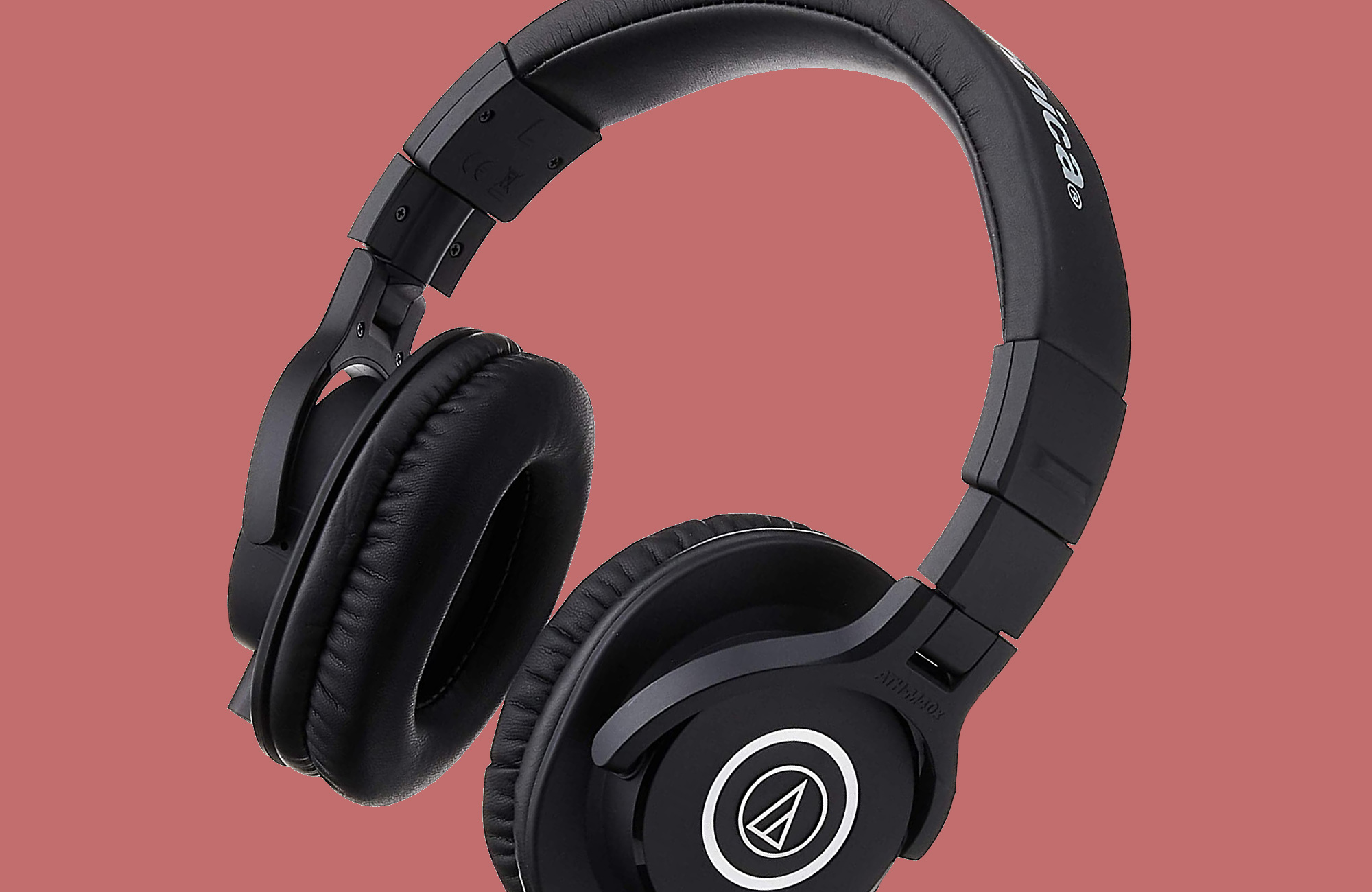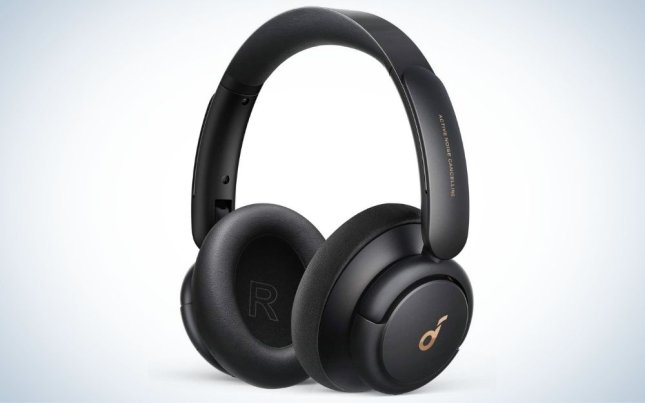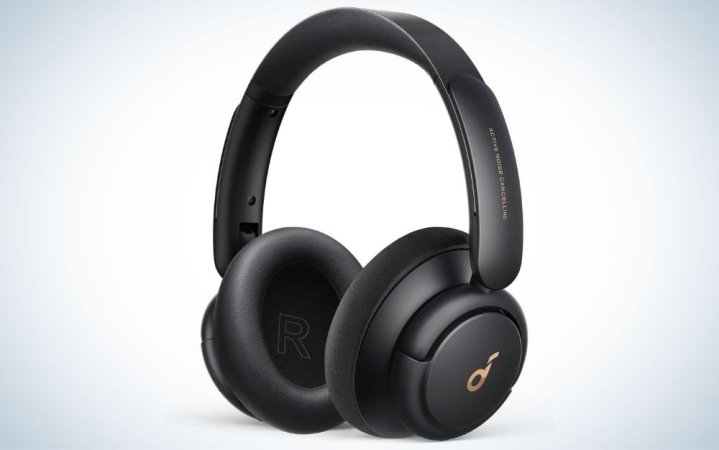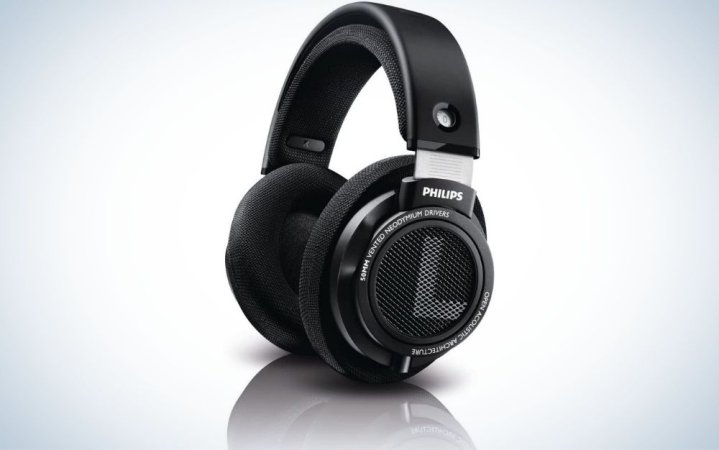We may earn revenue from the products available on this page and participate in affiliate programs. Learn more ›

Headphones are more than a luxury; they have become almost a necessity. Not only do they let you listen to your favorite music privately and on the go, but they also keep you connected during work calls, Zoom meetings, studio sessions, and more. Headphones are an essential part of everyday life for avid audiobook listeners, podcasters, beat-makers, and workout playlist enthusiasts. While expensive models can deliver incredible sound, you don’t need to break the bank to get the isolation and audio fidelity you crave, so long as you’ve identified your priorities. Whether you’re looking for well-rounded sound, wireless connectivity, or built-in call features, our budget-friendly list of the best headphones under $100 has you covered.
- Best overall: Audio-Technica-ATH M40x
- Best noise-canceling: Anker Soundcore Life Q30
- Best for podcasting: Sony-MDR7506
- Best wireless: Jabra Elite 45
- Best open-back: Philips SHP9500
- Best budget: UrbanEars Plattan 2
How we chose the best headphones under $100
In order to find the best headphones under $100, I relied heavily on real-world experience; I personally use several of the models listed here both for professional work as a sound designer and as supplementary headphones for quick, on-the-go trips. Beyond my stash, I did extensive research into first-hand user impressions and technical reviews by reputable publications. Below, you’ll find the result: multiple styles and connectivity options to suit a variety of listeners, music makers, and more.
Best headphones under $100: Reviews & Recommendations
While you may not be able to snag top-of-the-line tech, you don’t have to sacrifice satisfying sound, noise cancellation, wireless connectivity, or other features when picking from our selection of the best headphones under $100.
Best overall: Audio-Technica-ATH M40x
Best overall
Pros
- Sound Quality
- Comfort
- Suitable for the studio
Cons
- Can be a bit bulky
- No microphone
Why it made the cut: The ATH M40x headphones perform very well when it comes to satisfying sound with clarity suitable for use on recording, mixing, and mastering projects.
Specs
- Connectivity: Wired
- Style: Over-ear
- Frequency response: 15Hz – 24kHz
The ATH M40x is a great pair of cans for those looking for an affordable option for studio work. DJing, or casual listeners who prioritize fidelity. Large and in charge, these cans feature 40mm drivers in well-padded cups, which help reinforce low end and extend transients around an accurate midrange, supporting a neutral but energetic sound. Each pair comes with two detachable cables, one coiled and one straight, that terminate in a 3.5mm connector with a 6.3mm screw-on adaptor for use with audio interfaces, mixers, A/V receivers, and headphone amplifiers (the sensitivity makes these perfect for any mobile or desktop device, however, regardless of power). The build is sturdy yet flexible, with 90-degree swivel ear cups and collapsible hinges for increased portability. The M40xs are designed with sound in mind and do not include special features like active noise cancellation, wireless connectivity or a built-in microphone. They are not well-suited for those looking for a super-compact, lightweight option, but they are the best headphones under $100 if you’re looking for something that excels when it comes to physical durability and sonic integrity. While the retail price can go up to $120 depending on source, they can be regularly found new for under a C-note, as well as refurbished.
Best noise-canceling: Soundcore By Anker Life Q30
Best noise-cancelling
Pros
- ANC
- Long battery life
- EQ presets
Cons
- No aptX support
Why it made the cut: These budget-friendly Anker headphones will fool you into thinking they are high-end with all the included features.
Specs
- Connectivity: Bluetooth 5.0, Aux
- Style: Over-ear
- Frequency response: 16Hz – 40kHz
If you’re looking for a pair of headphones with Bluetooth and any other additional fancy features, go for the Q30s. They have managed to pack in many of the draws a premium pair has but at a fraction of the price. Not only are they ANC-equipped, but they also have three modes to choose from: Transport, which reduces airplane engine noise; Outdoor, which minimizes traffic sounds and wind; and Indoor, which silences typing, chatting, and other bothersome acoustic annoyances (or there’s a Transparency mode if situational awareness is a must). The 40mm drivers and Custom EQ feature contribute to a mix of clarity and kick. Bluetooth AAC and SBC codecs assure maximum compatibility to iOS and Android devices (though there’s no improved aptX fidelity for the Google OS users). A 40-hour battery life (60 hours with ANC turned off) will keep you connected for days at a time, and fast charging means you can get up to four hours of renewed life from just five minutes on the charger. Not one but two built-in microphones keep calls clear, and multipoint pairing allows you to connect multiple smart devices at the same for easy switching from your phone’s playlist to your computer’s Zoom meeting. Snag it on the Soundcore website.
Best for podcasting: Sony-MDR7506
Best headphones for podcasting
Pros
- Audio Quality
- Comfortable
Cons
- Replaceable pads can degrade over time
- Long Cable
Why it made the cut: A studio staple, the MDR-7506 headphones have been used by professionals since the early ’90s and they won’t be going anywhere any time soon.
Specs
- Connectivity: Wired
- Style: Over-ear
- Frequency response: 10Hz-20kHz
The Sony MDR7506 headphones are an industry standard that won’t break the bank. Used in professional studios for decades, these cans feature 40m drivers, neodymium magnets, and a frequency response of 10Hz – 20kHz. Sound quality is accurate with support across all frequencies, so vocals, instruments, and effects come through clearly. With the goal of producing a neutral sound profile, this pair doesn’t add or emphasize any particular frequency. Bass on “Monster” with Kanye, Jay-Z, and Nikki Minaj is clean and present without being overpowering. Midrange vocals on Suzanne Vega’s “Tom’s Diner” are crisp, with a slight lift above backing. Effects on design-heavy podcasts like Radiolab across various ranges are detailed; you’re able to perceive subtle reverb effects, high-frequency drones, and backing environment beds. I, personally, use this very pair (the very pair shown above) to mix and master audio for theatrical design, audio dramas, and podcasts.
The earcups are very comfortable and suitable for long work sessions, and the closed-ear design gently reduces background noise without altering your mix bleeding too much. After a few years of use, you may need to replace the earpads but ordering new covers is quick and easy. In fact, you might want to grab new pads right away if you want to increase passive noise cancellation. This pair comes with a coiled 9.8-foot cable ending in a 3.5mm gold-plated plug for a reliable connection; should you want to connect to an interface or amp, a threaded 6.3mm adaptor is included (along with a carrying case). The cable is long but not unruly, though it’s certainly too long to use casually on a commute. The build is mostly plastic, which can feel slightly flimsy, but I still use the same pair I purchased six years ago.
While these certainly aren’t the headphones you’ll want to take with you to the gym or for a work meeting, they are a sturdy, reliable pair for all your production needs. At only $100, we wouldn’t hesitate to stock up so you can share with studio guests. If you’ve already spent a bunch on podcasting microphones and are still looking for studio-quality sound but want to spend a little less, check out the AKG K240, which is a workable solution but a little less of a workhorse.
Best wireless: Jabra Elite 45
Best wireless
Pros
- Battery Life
- Quick Charge
- Custom EQ
Cons
- On-ear design isn’t comfortable for all
- No active noise cancellation
Why it made the cut: The Jabra Elite 45 headphones deliver the most when it comes to wireless headphone battery life on a budget.
Specs
- Connectivity: Bluetooth 5.0
- Style: On-ear
- Frequency response: 20Hz – 20kHz
We all know the pain of pushing through our morning commute in silence because our headphones died halfway there (or, even worse, overnight). If you are an all-day listener or, like us, often forget to recharge in a timely manner, the Jabra Elite 45 is likely the best option for an affordable pair of headphones. The 40mm drivers, wrapped in a compact, comfortable cushion, can get up to 50 hours of battery life from just one charge and, when you inevitably need a boost, a 15-minute quick charge can provide up to five hours of life. You can also keep listening while your headphones charge via USB.
On top of the impressive battery, you also get access to the Jabra “My Sound” app, which allows you to customize EQ or choose from available presets. Two built-in microphones can support clear phone calls and connect you to voice assistants like Siri, Alexa, and Google Assistant—which you can trigger by toggling an onboard button. Most users report a super comfortable fit and feel, though some listeners simply don’t like on-ear models across the board and prefer the cups to surround the ear (if that’s your style, scroll back up to the Soundcore by Anker Life Q30).
Best open-back: Philips SHP9500
Best open-back
Pros
- 50mm drivers
- Great sound quality
- Comfortable
Cons
- Sound bleed, in both directions
- Can be a bit bulky
Why it made the cut: The Philips SHP9500 delivers impressive, clear sound that will transport you from a silent room to a symphony hall.
Specs
- Connectivity: Wired
- Style: Over-ear, Open-back
- Frequency response: 12Hz-35kHz
These open-back headphones are a great option for serious listeners who prioritize a stellar sound profile over portability. A purpose-built pair, the SHP9500s don’t concern themselves with built-in microphones, Bluetooth, EQ presets, or compatible apps; instead, they focus on transportive sound with large, angled 50mm neodymium drivers that deliver an impressive 12Hz-35kHz frequency response and a spacious soundstage. The open-back design allows for improved imaging, spreading a track out in a way that enhances your ability to properly mix and master, or just appreciate, music. The removable cable removes a point of failure, adding value to your investment. And roomy, breathable ear cushions plus a padded, ergonomic headband mean your listening sessions can span more albums comfortably.
Just remember, if you can hear the outside world, the outside world can likely hear you. Open-back headphones aren’t a great option for recording music or dialogue, because the sound bleed is likely to be picked up by nearby microphones. But if you have a serene sanctuary available (and invest in a great DAC/amp or DAP), the SHP9500 can transform that airiness and help you become one with the music. These headphones are an affordable entry into the audiophile realm, and the precision of directional sounds adds authenticity and authority to gaming, as well (though you’ll need to add a standalone streaming mic).
Best budget: Urbanears Plattan 2
Best budget
Pros
- Price
- Multiple stylish colorways
- Option for wired connection
Cons
- Volume is limited
- Onboard control knob is hard to use
Why it made the cut: The Plattan 2 is a sturdy pair of headphones, with solid sound, easily making them some of the best headphones under $100.
Specs
- Connectivity: Bluetooth, Aux
- Style: On-ear
- Frequency response: 20Hz-20kHz
The Plattan 2 from Urbanears is an excellent option if you don’t want to pay more than $65 for a stylish, sleek pair of headphones. I’ve used these headphones as a backup when I forgot to charge my everyday pair and found the fit to be comfortable and the audio quality to be solid. The bass might not blow you away, and the high end isn’t always crystal clear, but, overall, frequencies across the spectrum are supported. Thirty hours of battery life will keep you in business for at least a few days and these things hold a charge, even when listening at a high volume. The single onboard control knob can take a second to get the hang of, but once you do, you’ll be able to adjust volume, play/pause, skip songs, and answer phone calls. Pressing down on this knob will also turn the headphones on or off with a long press, triggering Bluetooth pairing mode. If you’re trying to connect to a non-Bluetooth-equipped player, like an airplane screen or handheld gaming device, you can use the included 3.5mm audio cable.
Things to consider before buying the best headphones under $100
Before picking a pair of affordable headphones, consider what you’ll be listening to and where you’ll be listening. Select a model with the features that will fit your needs, whether that be noise-cancellation, studio-quality sound, a long battery life, etc. Get specific: the best headphones under $100 for recording the next great murder mystery podcast might not work for the marathon-runner in training. Consider all the technical specs of the speakers you’ll strap to your head and take stock of any features before adding anything to your cart.
Hoping to leave wires behind?
There are some excellent inexpensive wired headphones, but those won’t work for all. With the increased availability of Bluetooth options (and Apple’s decision to forgo a traditional headphone port on the iPhone), most of us don’t want to go through the hassle of locating an adaptor or remain tied to our phones. So while an analog connection will be right for some, know that there are many wireless options out there. Before you grab a pair of Bluetooth headphones, consider connectivity range (i.e., how far away you can be from your device before the sound quality suffers and you get disconnected), battery life, and Bluetooth version. Bluetooth versions typically range from 4.2 to 5.3 and the higher the number, the better the connection with faster data transfer speeds and an increased range.
Diving even deeper, Bluetooth codecs describe how your digital audio data is encoded and decoded from a source device to your speaker or headphones. To get the most from these high-speed transfers both your receiver and transmitter need to be equipped with the same codecs. The most common codec to see is SBC, which every Bluetooth device supports. While not the highest-quality codec, it’s a virtually universal, reliable way to transfer data. If you’re an iOS user looking for higher quality, consider a speaker with AAC, or Advanced Audio Coding. If you have an Android smart device, select a speaker with aptX/aptX HD/aptX Adaptive (or LDAC) support for faster transfer rates that preserve more data (and dynamic range).
Do you need to tune in, zone out, and turn off the outside world?
If you’re looking to drown out the din of your morning commute or simply need a little peace and quiet at home, a pair of headphones with active noise cancellation (ANC) might be the game-changer you’re looking for. ANC works by analyzing the noise from your environment and generating a reflection that counteracts what it “hears,” letting only your music get through. While the science of waveforms and phasing can get a little complicated, what you need to know is that headphones with active noise-cancelling are able to drown out most if not all environment noises along with a chatty coworker. Some headphones come with the option to turn ANC on or off, should you need to tap into your surroundings. A few select affordable models let you customize your sound further with options for adaptive EQ, preset listening modes, and app control. Of course, these options increase with a higher budget, but never fear: we’ve found one or two that will get you premium features for a fraction of the price.
Are you a podcaster or producer?
If you’re looking for a pair of headphones to help you record music, mix a film, or master your podcast’s new season, pay attention to the technical specs and prioritize sound quality. Of course, you’ll need to forgo wireless connectivity, but you might also have to settle for a simpler, practical design typical of studio-quality cans regardless of price. Go for an over-the-ear design with a closed or open back. Closed-back headphones provide more passive noise cancellation and prevent sound bleed for cleaner recordings. Open-back models provide little to no cancellation, allowing the environment to be present but often achieving more natural sound. Look for a model that boasts about its properly tuned large, dynamic drivers and wide frequency response range so you can hear every note and every catch-breath.
Do you want to talk as well as listen?
Sometimes on-the-go listening is less about music and more about the work-from-home “meeting” you are “attending” while sneaking a walk in the park. If you find yourself pausing your music every few minutes to rip out your current headphones and answer a phone call, make sure you look for a new pair that includes a built-in microphone. Not every built-in microphone is designed equal, however. Some are equipped with advanced technology to isolate your voice and silence background noise, making calls clearer for those on the receiving line. Some can utilize voice activation to answer calls or be triggered by touch-sensitive controls. Finally, built-in microphones can connect you to voice assistants like Siri and Alexa.
What can you get for under $50?
There is no shortage of wireless headphones available for $50 and under, but many of them can’t really compete with some of the more expensive options when it comes to fun features and support across the frequency range. But just because your options are limited doesn’t mean you can’t find a solid pair of headphones if you do your research, focusing on your top priority. You may have to sacrifice a bit of battery life for better audio quality or settle for passive noise cancellation in favor of more advanced Bluetooth connectivity.
FAQs
The difference is that open-back headphones, as the name denotes, have open (technically semi-open) earcups, typically covered with a perforated shield of some sort. This allows for a sound that’s best described as airy, but it also allows for what’s happening in the headphones to be heard outside them, and vice versa. Closed-back headphones, meanwhile, have a solid exterior and create a seal around the ear, providing passive noise cancellation. Generally speaking, open-back headphones can produce more natural-sounding audio with accurate imaging—traits beneficial if you’re mixing and mastering or listening to high-quality files at home. Closed-back headphones are preferred for everyday casual listening, recording, and use during travel or commutes (not only will they not disturb the person sitting next to you, but the elevated low end innate to the style of headphones will help drown them out).
Headphones run the gamut when it comes to price, ranging between $10 to thousands of dollars. Unless you’re mixing and recording high-end audio professionally, your headphones should be thought of as a portable tool that you don’t need to invest too much of your salary into. That’s not to say you should skimp on audio quality, but simply reach for what you can afford. If your budget allows you to make some upgrades, a more expensive pair retailing over $100 can certainly be worth it.
Yes, if misused headphones can cause hearing loss, and children are the most susceptible, which is why many pairs of kid’s headphones have a built-in volume limiter. Most smartphones (as well as the Apple Watch Series 7, among other wearables) include an app or tool that can tell you if you’re listening at dangerous levels by monitoring decibels. You generally don’t want to listen to anything louder than 85 dB for a prolonged period of time.
Final thoughts on the best headphones under $100
Shopping for an affordable pair of headphones can be a daunting task, with hundreds of options out there. Sure, there’s not a ton to lose monetarily, at least compared to the many hundreds or even multi-thousands some spend on audio, but there’s also so much to gain from choosing the right model. Thankfully, so long as you know what you’re looking for, you’ll be able to weed out what you don’t need until you’re left with the best headphones under $100 for you. Think about where and when you’ll be using your new headphones the most, consider which features will best support your listening experience, and start prepping to binge a new season of “Serial.”









